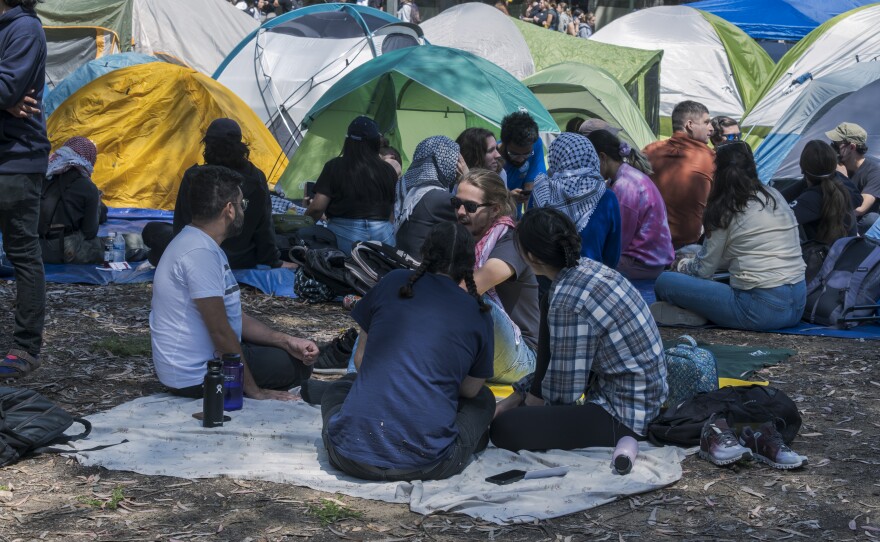Michael Drake, the president of the University of California, wrote a letter last month telling the system’s 10 campuses to ban encampments and regulate other protest-related conduct.
But, as the letter references, most of those regulations were already on the books for the schools. The schools simply haven’t enforced them with regularity. That’s a fact highlighted by spring protests at UCLA and other UC campuses that saw police arrest hundreds of students who built the patchwork of unauthorized tents, barricades and temporary structures that made up the encampments.
Drake’s letter to the heads of all 10 campuses banned several things that were already largely enshrined in laws and campus policies, mainly:
- Camping, tents and encampments, as well as a ban on structures, on campus grounds
- Blocking the movement of other people on campus, including access to campus
- Blocking facilities, spaces, building entrances and other campus paths and roadways
- Using masks to intimidate others or to conceal one’s identity after violating a law or policy
- Refusing to identify themselves to campus officials when asked
Drake told campus chancellors to present existing policies — like those relating to encampments, impeding movement around campus, blocking facility and building entrances and using masks to conceal identity — on a single page on their respective university websites. Any campuses without such rules should create them, Drake wrote.
At minimum, Drake’s letter to campuses helps to fulfill a legislative mandate requiring each UC campus to articulate how it will respond to threats to safety or disruptions of campus operations. The system must also spell out the consequences for individuals who violate campus policy. The legislation requires campuses to post these before the start of the fall term. Lawmakers will release $25 million in state funds to the UC once they receive a report from the UC detailing its efforts. The report is due by Oct. 1.
But why weren’t those policies already enforced?
New policy gives campuses discretion, like before
Through several emails, a spokesperson for the UC Office the President shared the administration’s thinking, at times neglecting to offer clear answers to questions from CalMatters.
Asked why the public should trust the campuses to enforce the newly articulated rules Drake detailed last month when most campuses didn’t enforce their own rules last spring, spokesperson Stett Holbrook said that UC campuses can show discretion in how they respond to protests. But “given the size of the recent protests, the number of non-UC affiliates involved, the public safety threats, and the simultaneous nature of the protests, our campuses endured an unprecedented level of stress.” That the protests occurred across the UC system showed the UC leaders that campuses “needed to better communicate and more uniformly apply policies impacting expressive activities to provide for greater consistency, clarity and support for all our campuses.”
Holbrook’s responses, echoing Drake’s letter, acknowledged that “most campuses already have existing policies that cover the prohibited categories of conduct” but that by the start of the school year, every campus is “expected to communicate about and enforce their policies in a clear and consistent manner going forward.”
“Chancellors meet with their student body president once a quarter, and that’s it. And so it’s especially alarming for students to not have a voice about their public dollars.”— Aditi Hariharan, president of the University of California Undergraduate Student Government Group
“A lot of these policies have been in place at campuses, like almost every campus has something against camping, encampment structures,” said Aditi Hariharan, president of the UC-wide undergraduate student government group. She said the policies are being crafted without student input — part of a larger problem with how frequently chancellors confer with student government.
“Chancellors meet with their student body president once a quarter, and that’s it,” Hariharan said. “And so it’s especially alarming for students to not have a voice about their public dollars.”
She’s particularly alarmed by the rules on masking, which in Drake’s letter don’t offer dispensations for individuals who wear masks or facial coverings for health or religious reasons. UC has subsequently indicated that “masking to protect one’s health” is permissible, Holbrook wrote.
Less clear is why some campuses, including UCLA, didn’t initially follow their own rules when the encampments emerged last spring. The public relations division of UCLA never replied to those questions when CalMatters asked them in April — when the encampment was still ongoing — nor when CalMatters asked again several times last month.
Holbrook had this to say, but didn’t answer additional questions about the UC Office of the President’s communications with campus leaders when the encampments first emerged: “The uniform enforcement of any policy is always a challenge in a system as large and diverse as UC. We strive to strike the right balance between enforcement and flexibility to do what is in the interest of the communities we serve — especially when it relates to expressive activity.”
Campuses let encampments grow in spring
UCLA became Exhibit A in the national discourse over student protests, violence and police reaction. The university’s pro-Palestinian encampment was attacked by counter-protesters April 30; about a day later, a phalanx of police officers from multiple agencies began clearing it.
At the time, the campus had rules that banned, in all but select cases, camping and lodging. The rules also prohibited actions that “block entrances to or otherwise interfere with the free flow of traffic into and out of campus buildings” and that “willfully interfere with the peaceful conduct of the activities of the campus or any campus facility by intimidating, harassing, or obstructing any University employee, student, or any other person having lawful business with the University.”
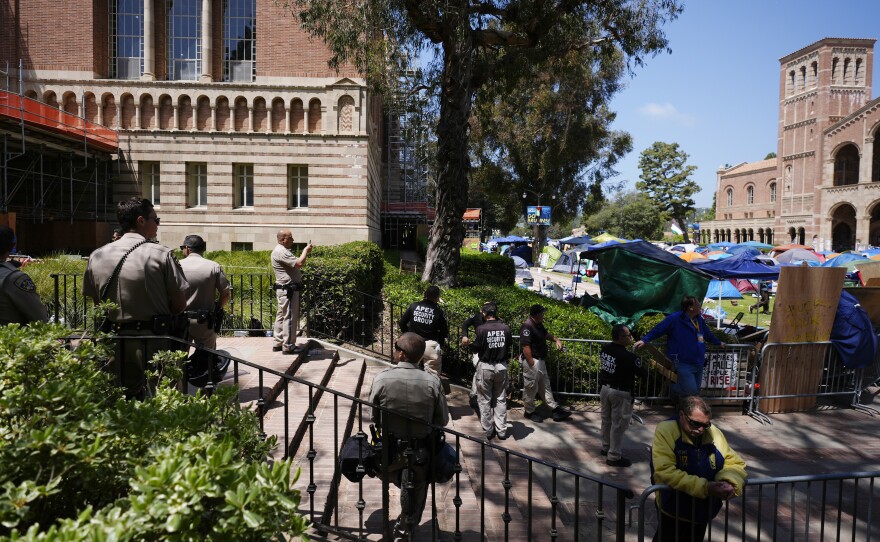
Protestors at the encampment obstructed whole pedestrian walkways when a CalMatters reporter visited the campus April 29 and 30. Students also blocked doorways into buildings near the encampment, used barricades to halt public access into a central courtyard where the encampment protestors pitched overnight tents and adorned the facades of campus buildings with paint, graffiti, signs and other markings that violated another campus policy. Encampment protesters would only permit individuals with certain colored wristbands to enter or have someone from within the encampment vouch for them.
Samuel Ahmed, a UCLA graduate student who was a spokesperson for the encampment, said on April 29 that the encampment emerged out of deep frustration that the UC continued to invest in weapons manufacturers and other companies with ties to the Israeli government. Since last fall, pro-Palestinian students were demanding that the UC divest, to no avail.
“I think that maybe because nothing has changed we feel even further motivated to protest right now,” Ahmed said then.
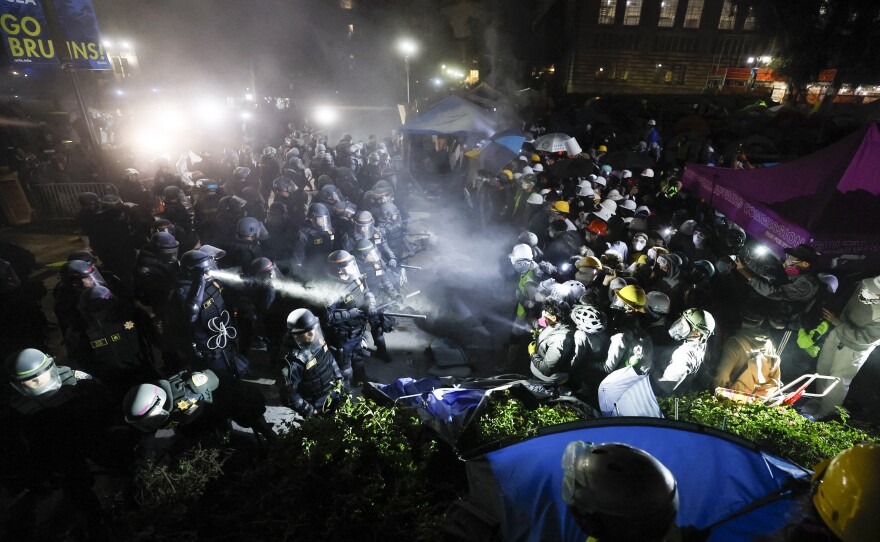
A day later, on April 30, violent counter-protesters besieged the encampment while campus safety and other police failed to intervene for hours. Earlier that day, UCLA officials formally told the students their encampment violated school policy and that they needed to disperse.
Early morning of May 2, UCLA leadership summoned the police to clear the encampments, which included California Highway Patrol firing “less-lethal” rounds at pro-Palestinian protesters. Doing so appeared to go against training guidelines or state law.
Police spent several hours telling encampment protestors to clear the area before making arrests.
Shortly after those sweeps, Gene Block, the school’s chancellor then, wrote that “while many of the protesters at the encampment remained peaceful, ultimately, the site became a focal point for serious violence as well as a huge disruption to our campus.”
The campus arrests were also a main trigger for a series of campus strikes that UC graduate students orchestrated near the end of the spring term.
In late May and early June, protesters erected more encampments at UCLA that were swiftly taken down by campus authorities. The June 10 incident led to protester arrests.
In September, UCLA published updated rules on protests and free expression that align with Drake’s letter. The campus also seeks to build empathy among students with opposing views. Last November, Drake committed $2 million in system money to “combat extremism.”
Taking down encampments
Drake’s letter also spelled out how campuses are supposed to handle protesters who violate laws or campus policies — actions that largely mirror what campuses like UCLA and UC San Diego pursued with their encampments.
First, campuses need to tell protesters what rules they’re violating and the consequences if they don’t halt those violations. Next, police or fire officials may issue an order of unlawful assembly. If protesters don’t leave then campuses may summon university police and other law enforcement agencies to make arrests. The campuses may then pursue disciplinary action against students and staff.
Carol Christ, who retired as UC Berkeley’s chancellor this summer, told the Los Angeles Times that “she resisted pressure from University of California regents and others to take down a pro-Palestinian encampment — using police forces if necessary.”
She added that in her experience, “protests don’t end with police action. They end with negotiations. Every time there’s been police intervention in a protest, it’s tended to escalate the protest.”
Protesters at UC Riverside, UC Davis and UC Merced cleared their encampments voluntarily.
“Protests don’t end with police action. They end with negotiations. Every time there’s been police intervention in a protest, it’s tended to escalate the protest.”— Carol Christ, former UC Berkeley chancellor
UC San Diego’s leadership explained its rationale in clearing the encampment on its campus with police in a timeline published on the campus website. Similar to UCLA, the San Diego campus had clear rules prohibiting overnight camping and blocking pathways but permitted the encampment to remain for five days before summoning law enforcement agencies who arrested 64 people, including 40 students. Some protesters were pepper-sprayed by law enforcement, according to media reports.
On day one UC San Diego told protesters that their encampment was illegal and that members were in violation of campus policy. By the fourth day the encampment had tripled in size and instituted checkpoints, a security perimeter and was receiving support from outside organizations, the university website said.
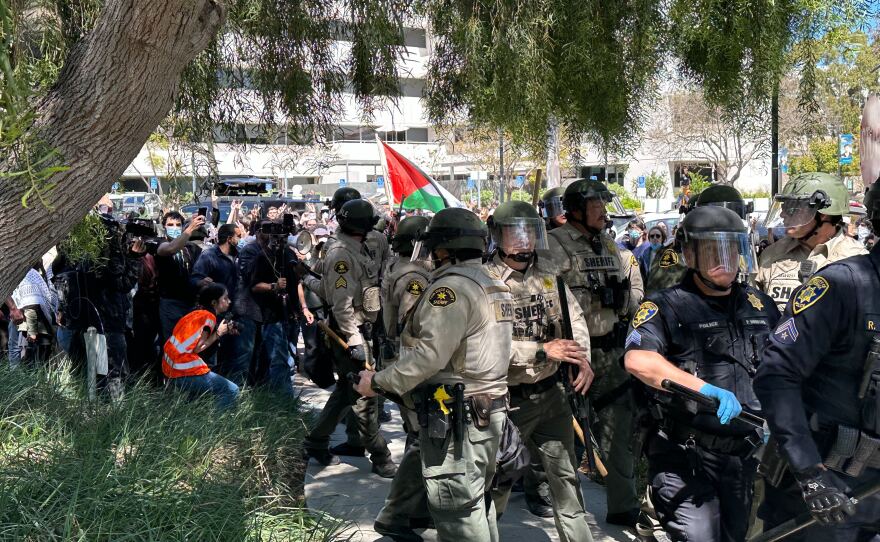
University leaders were concerned about a repeat of violence between encampment protests and counter-protesters, similar to what occurred at UCLA a week prior. UC San Diego campus security forces would have been “overwhelmed” and unable to stop violence had it occurred, the university website said.
“University leaders determined that waiting for something more dangerous to happen … was unconscionable,” the university summary reads.
Last spring’s protests playing out in courts
As the UC system looks ahead to the new school year, various cases are still scrutinizing the past. Last month, a federal district judge said that some Jewish students were blocked from entering the UCLA encampment.
“In the year 2024, in the United States of America, in the State of California, in the City of Los Angeles, Jewish students were excluded from portions of the UCLA campus because they refused to denounce their faith,” wrote the judge. “This fact is so unimaginable and so abhorrent to our constitutional guarantee of religious freedom that it bears repeating, Jewish students were excluded from portions of the UCLA campus because they refused to denounce their faith.”
The judge agreed with Jewish students who said that the anti-Israel sentiment displayed by protestors in the encampment — and that the encampment protestors publicly blocked supporters of Israel from entering — violated their religious liberties because of their spiritual ties to Israel. Various Jewish groups debate whether anti-Zionism is inherently antisemitic. The UCLA encampment included Jewish participants.
About a week later, the UC system leadership decided to comply with an order requiring the campus to end programs or events from which Jewish students are excluded, Politico reported. Under UCLA’s existing rules and the ones reinforced by Drake, such checkpoints wouldn’t be allowed anyway.
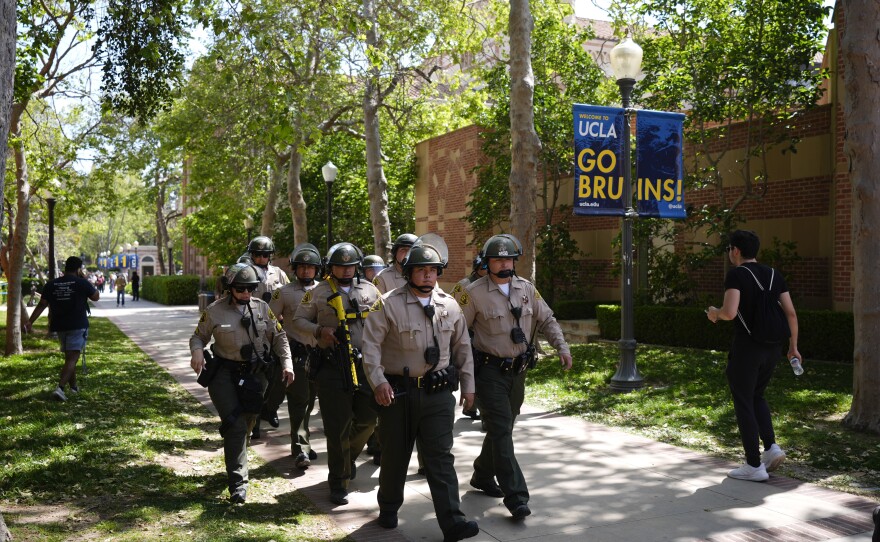
Meanwhile, a coalition of civil rights attorneys are suing the University of California and UC Santa Cruz, claiming that they pursued “unconstitutional” and “overbroad” sanctions against more than 100 pro-Palestinian students and faculty who protested last spring and were subsequently arrested and banned from campus for up to two weeks.
“The impact of being instantaneously banished from campus was devastating,” reads the suit, which was filed last week. “Individuals lost access to housing, jobs, classes, school resources, health care, and other campus services.”
The lawyers are representing two UC Santa Cruz students and one faculty member. They’re specifically asking a county judge to order UC Santa Cruz to comply with a state Supreme Court litmus test for when a campus can ban a student or faculty member without a hearing and a determination that they pose a threat to campus life.
The suit has added resonance given Drake’s letter to the chancellors, the lawyers wrote. Without a judge order, the lawyers wrote that the campus may “continue their unlawful practice” of blowing past that litmus test.
Days after the suit was filed, one of the legal groups behind the suit, ACLU Foundation of Northern California, published an explainer on students’ protest rights in California.
A senior spokesperson for UC Santa Cruz, Scott Hernandez-Jason, said the campus is committed to free expression and preserving access “to education, residences, and campus facilities free from obstruction.” He said that the school’s leadership is “confident that decisions made in the spring were necessary and critical to preserve safety, access, and operations of the campus.”


